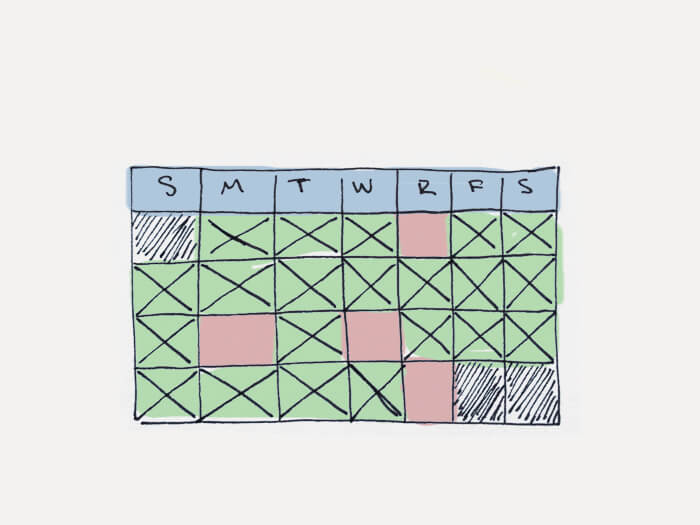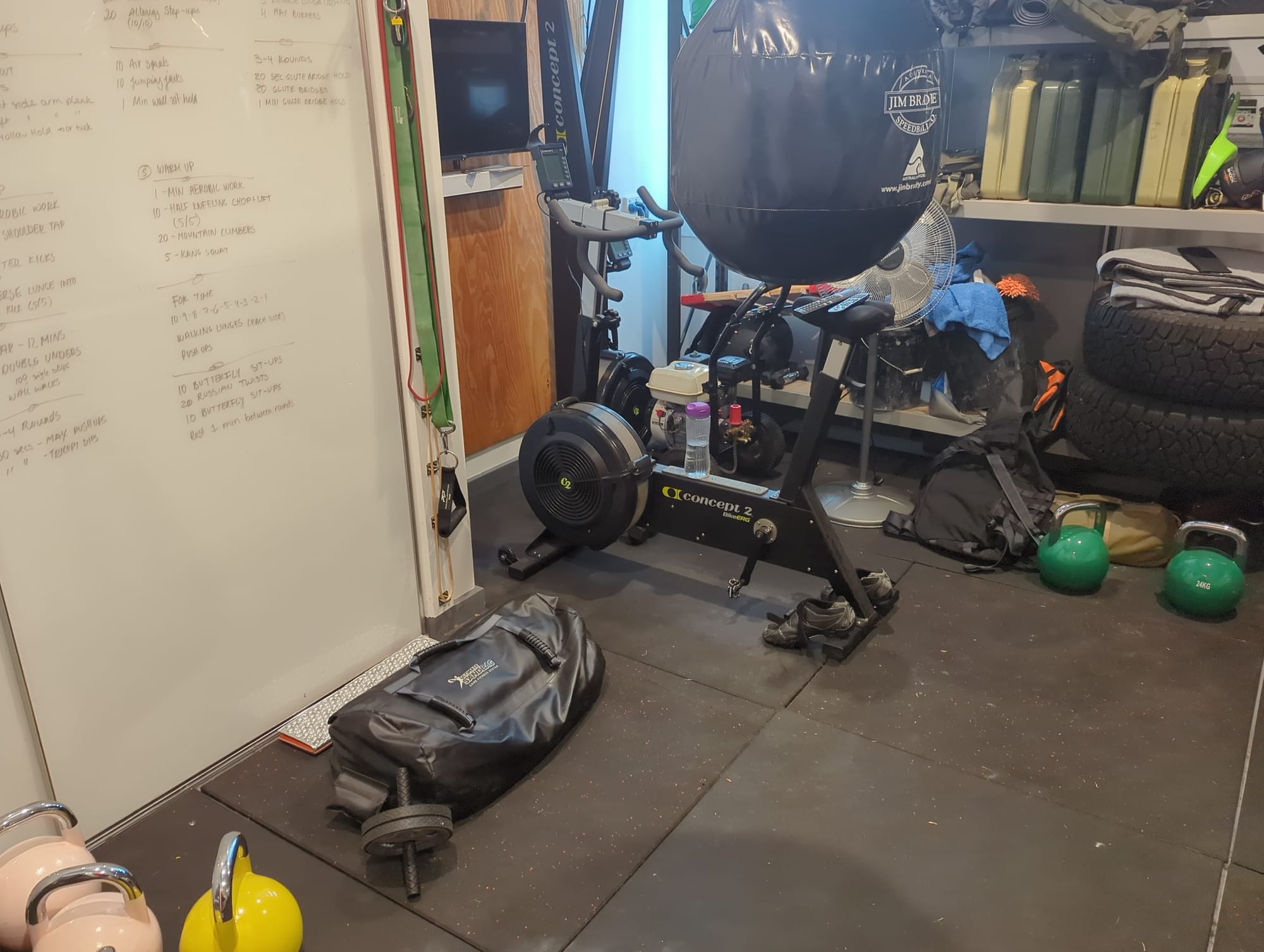Finding time to exercise and maintain a healthy lifestyle can be a challenge. Many of us struggle with balancing work, family, and personal commitments, often putting our health on the back burner. However, staying fit and healthy doesn’t have to be overwhelming or time-consuming.
Through my personal journey with various forms of exercise—from high-intensity interval training to marathon running—I’ve discovered that the key to sustained fitness lies in simplicity and consistency.
This article shares my daily workout routine, a straightforward approach that can help anyone get fit and healthy by incorporating small, manageable exercises into their daily life.
My goal here is to offer you an easy-to-follow plan that doesn’t require expensive gym memberships or hours of free time—just a commitment to yourself.
My Exercise Journey
I've always been conscious of my weight. In high school, we had to swim weekly during the summer, and wearing DTs (dick togs) made me particularly self-conscious. The bullying I experienced only reinforced my determination to exercise regularly and stay strong.
When I went to university, I hit the gym hard. I got into supplements, built strength, and bulked up, but I never quite achieved the lean, toned physique I wanted. Once I started working, time for exercise became scarce, and staying fit took a backseat for a few years.
After finishing up with the project building company I worked for, I realised I needed to prioritise my health and well-being over just working constantly. I threw myself into HIIT training, which I did consistently for four years. Then, I transitioned into boxing circuit training for another two to three years before dedicating myself to boxing, including sparring and technique training, for the next four years.
However, after four intense years of boxing, I grew tired of getting hit in the head (unsurprisingly, given it's boxing!). So, I moved into MMA fitness training for the next two years. After that, CrossFit seemed like a logical progression in terms of fitness intensity, and I committed to it for a solid four years, doing at least 4-5 WODs a week. Unfortunately, my shoulder mobility wasn't great, and I struggled with supraspinatus related shoulder issues, particularly during overhead presses.
Next, I turned to trail and marathon running. I found trail marathons much more engaging than road running, which I found dull and annoying, especially dodging cars on Brisbane's roads and footpaths. After completing a few full marathons and several half-marathons, I wrapped up my running journey with the Gold Coast Marathon. I aimed to break 3:30 but ended up with a 3:45, thanks to one of my calves deciding to rebel at the 32 km mark.
I then returned to HIIT circuit training at my local gym, which was great fun at 5 a.m. with a lively group on the Gold Coast. I did this for three years until I started a new role.
The new role was with a start-up company, and it was anything but enjoyable. The stress and staff issues were relentless, and the company was essentially doomed from the start. During this time, I began working out from home, creating my own programs and getting heavily into trail hiking.
You don't need an expensive membership to get fit!
You don’t need an expensive gym membership to get fit and healthy or to reach your fitness goals. While some people enjoy the group dynamics and accountability that come with attending a gym, it’s not a necessity.
With the right mindset and a few pieces of basic equipment, you can easily achieve your fitness objectives on your own, right at home.
This workout routine is designed to be simple, cost-effective, and adaptable to your schedule, making it easy to stay consistent without the need for a gym. You can build strength, improve your health, and meet your fitness goals—all on your own terms.
A Low-Impact Approach to Fitness
This workout routine is low-impact, making it accessible for everyone, regardless of your current fitness level. This approach focuses on getting you moving and building strength in a safe, sustainable way.
The exercises in this routine are selected specifically to minimise strain on your joints and muscles while still providing an effective workout. Low-impact doesn’t mean low results—it’s about working smarter, not harder.
By focusing on controlled, deliberate movements and emphasising proper form, you can build strength, improve mobility, and boost your overall fitness without the wear and tear that high-intensity exercises can sometimes cause.
This routine is especially beneficial for those who have experienced injuries in the past, or who simply want to avoid the potential risks associated with more intense workout programs.
The goal here is to create a strong, resilient body that can handle the demands of daily life with ease—without breaking down in the process. Remember, the best workout is one that you can do consistently, and this low-impact approach ensures that you can keep moving, stay strong, and feel great for the long haul.
My Workout Gear
My workout gear consists of a few essentials: kettle bells (8kg to 24kg) , heavy slam balls (ranging from 8kg to 70kg), an ab mat, an ab roller (yep, the thing your mom had in the 80's), adjustable rings, a pull-up bar mounted to the garage ceiling (which the rings attach to), rubber exercise bands of various sizes and thicknesses, skipping ropes, weighted sandbags (10kg to 50kg), and most recently, an 8kg weighted club and a broomstick (a timber dowel from Bunnings).
Where I Am Now and What Works Best for Me (and perhaps you too)
Getting into a routine is the hardest part of any workout. The easiest way I've found to start and maintain a consistent exercise routine is by using a simple daily habits app.
This approach isn't ground breaking, but it's the method that works best for me. If you want to learn more about this technique, look up how Jerry Seinfeld uses the "Don't Break the Chain" habit method to become a comedian.

I've found that the best way to work out daily is not by doing one long session but by chipping away at it throughout the day and focusing on weekly volume. This way, I don't have to "carve out" a specific time slot or worry about juggling things around.
I set rep numbers for each exercise, then throughout the day—mainly during breaks from work every 30 to 45 minutes—I chip away at my daily workout volume by doing an exercise and its corresponding reps.
The rationale for this method is inspired in part by the book Eat That Frog, which essentially says to start your day by doing the thing you least want to do. In essence, rip the band aid off and get it done as soon as possible.
So here's my daily workout, I do this six (6) days a week, with a hike on the seventh day of the week (and no strength workout)
Strength Training
25 pushups
- First thing in the morning after using the toilet, before showering (Chest, triceps, back)
Do 25 pushups
25 ring rows
- (Back, shoulders, triceps, biceps)
Do 25 ring rows
25 leg raises with twist
- (Abs, hip mobility, lower back)
Do 25 leg raises with twist
25 KB suitcase lifts
- (Legs, back)
Do 25 KB suitcase lifts (each side or both at once)
25 couch tricep dips
- Yep, I bet you didn't think you'd try them again!
- (Triceps, shoulders)
Do 25 couch tricep dips
25 band pull backs (face level)
- (Back, shoulders)
- You can also do these without anchoring to something
- Just wrap your hands in the band ends
- Start out in front, above your head, then pull apart and back, finishing at your nose
Do 25 band pull backs (face level)
5 ab rollouts
- (Abs, shoulders)
- Get one of these from Big W (or you mom if she was into aerobics in the 80's 😄)
Do 5 ab rollouts
25 band bicep curls
- (Biceps, shoulders)
25 band bicep curls
25 windscreen wipers
- Laying on the floor, legs together and up, then lower with control to one side and then the other (Abs, hip mobility)
Do 25 windscreen wipers
25 KB racked front squats
- (Legs)
Do 25 KB racked front squats
- 2 minutes of calf/leg foam rolling (each leg)
Total Daily Rep Volume (all exercises): 230 reps
Total Weekly Volume per Exercise: 175 reps
By doing just one set of 25 reps, you avoid boredom and ensure you complete the exercise. The hardest part of exercising (and most things) is getting motivated to start.
The easiest way to do this is by breaking tasks into tiny, manageable pieces.
By doing this, you eliminate the mental back-and-forth of "Should I or shouldn't I?"—often the main reason we don't do things.

I was fortunate to hear BJ in person "back in the day" in Palo Alto
After a week, you'll think, "Well, that wasn't so hard—one week done." After two weeks, you'll realise you've been exercising every day for two weeks, you feel fine, you're not sore, and you won't believe you're actually doing it.
After a month, you'll start noticing that things are tightening up. You'll feel stronger, and you'll see changes.
So just keep going—don't stop.
Keep doing this, and in time, you'll start thinking about increasing your volume or adding exercises or other activities to your weekly schedule. By then, you'll have established a routine, and your week will naturally include time for exercise.
This is a self-fulfilling cycle, and it all starts with this simple workout.
Cardio
In addition to the strength work out above, you need to get moving outside, walking is the best way to start. Aim for 40 minutes morning and afternoon.
- Daily: Morning walk around the block - 4.8 km - 40 minutes
- Daily: Afternoon walk around the block - 4.8 km - 40 minutes
- Weekend (Saturday or Sunday): Hike a trail or a longer walk, at least 10-16 km (2.5 to 4 hours round trip). Aim to finish before lunch, so start early before it gets hot.
Note: On average, you'll hike/walk at a speed of 4 to 4.5 km per hour (depending on the terrain), which helps in planning your journey. Use apps like AllTrails, Gaia, or WikiLoc to find trails near you.
There’s a whole community of people out there walking, hiking, and uploading routes you can try yourself. Find a trail, read the trail notes, take water, food, a jacket (always), print out a map, and download the trail to your phone (with offline support) to navigate safely. Always tell someone where you're going, how long you'll be, and when you should be back or contactable.
Food
Obviously, food plays a huge role in feeling good. You can't exercise daily and then eat like a trooper and expect things to change. You need to be mindful of calories in and calories out. The easiest "diet" to follow is the Mediterranean diet—eat mainly chicken and fish, veggies, and whole grains, and eat red meat and eggs once a week only.
Alcohol
Just don't drink. It's the fastest way to feel better. Like me, you might drink to "forget" or "relax," but the truth is you're not doing either. You're actually making everything harder than it needs to be to get where you want to be. You might think you can't stop drinking because it feels like a big part of who you are, but it's not. Once you stop drinking, you'll find you have more time to do the things you want to do but previously felt you never had time for. Alcohol is the quickest way to lose time without any tangible benefit.
My theory of alcohol, acquired in my youth (which I ignored for many years but have adhered to since I stopped drinking 15 years ago), is this:
Alcohol keeps the masses occupied so they ignore what's going on around them.
Strangely enough, one of the best feelings you can get is taking a shower and enjoying a nice meal after a hike. The water feels different, the food tastes better, and you have the satisfaction of knowing you've accomplished something that, in the past, you might not have thought possible.
Hiking Gear
You don't need much to start hiking. A 15-20L backpack is ideal—not too big, not too small. It should have enough room for a water bladder (for longer hikes), a jacket, food/snacks, and a first aid kit.
Try This Out!
If you've been struggling to start exercising and don't know where to begin, try this out and let me know how it goes. If you don't have exercise equipment, like rings, substitute with something that targets the same muscle group.
For example, you can do a version of ring rows by lying under a table (or chairs) and pulling yourself up to the underside. It's just a hanging movement that lets you pull your body weight, contracting your back muscles.
Callisthenics style parallel bars are a great alternative to rings, and you can even build a set from materials you can source from Bunnings. Below is a YouTube video showing you how to do this.
Conclusion
Achieving and maintaining fitness doesn’t require drastic changes or exhaustive workout sessions. Over time, these small steps add up to significant progress. As you begin this daily workout routine, you’ll find that staying fit and healthy becomes a natural part of your life, not just another item on your to-do list.
My journey from heavy lifting to CrossFit, and finally to a balanced mix of strength training, cardio, and mindful eating, has taught me the value of persistence and simplicity.
Remember, the most important step is to start—no matter how small that start may be.
So, try out these strategies, stay committed, and watch as your body and mind transform. Your future self will thank you.
I’d love to hear about your experience with this workout—what different exercises have you added to your routine? Do you have any tips that could help others on their fitness journey?
Let everyone know in the comments how you've gone and the workouts you like the most.








